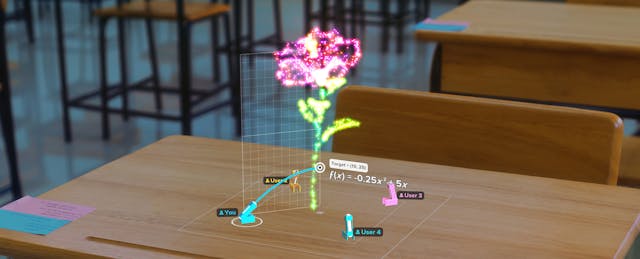Augmented reality (AR) is a technology that enriches the classroom learning experience by overlaying digital content onto real-world content, simply using devices that already exist in most classrooms, like tablets and smartphones. In educational settings, AR can be used in numerous ways to enhance teaching and engage students. It can bring traditional textbooks to life by adding interactive elements like videos, models or supplementary information to printed pages. AR is also a powerful tool for visualizing complex concepts, allowing students to explore abstract ideas through interactive 3D representations. Furthermore, it can transport students to different times and places, making history and geography lessons more immersive and educational.
Heather Brantley, an instructional technologist and teacher at a Texas junior high school, recognizes the value of integrating augmented reality tools into her lessons. Throughout her educational journey, she has spanned various roles, including teaching elementary math, instructing web communications for career and technical education students and serving as an edtech consultant and speaker. Recently, EdSurge spoke to Brantley about her experiences using McGraw Hill AR, a free app created by McGraw Hill in partnership with Verizon for Verizon Innovative Learning, an educational initiative that seeks to help bridge the digital divide with a goal of providing digital skills training to 10 million students by 2030.
EdSurge: What sparked your interest in incorporating more technology into your teaching methods?
Brantley: I was finding as a math teacher that on days I pulled out the manipulatives, I almost regretted using them immediately because they were everywhere, not to mention that schools are limited in having the funds to give enough manipulatives to everyone. It was just a mess. So, I started digging deeper into using technology [itself] as a manipulative.
The person who really helped me along this journey has been educational technologist Jaime Donally. I had the blessing of teaching her daughter and collaborating with her. Jamie would tell me about different tech products that could support what I was teaching. She has been an incredible resource in this learning journey, and through these experiences, I developed a passion for edtech.
My big focus on using tech for good is to use the tech that you have for good. One of the challenges for teachers is that schools do not provide enough devices. However, if you instead teach students how to use a device they already have in their pockets, you’re empowering kids to use technology anywhere.

How has incorporating AR in your classroom enhanced the learning experience for your students?
I don’t want to be a teacher who teaches at kids; I want to be a teacher who learns alongside kids. Augmented reality lets you explore together with your students. When a new update comes out on an app, I’ll tell students Let's explore together and be curious together. AR sparks curiosity in students so that they are asking, “How does that work?”
When McGraw Hill AR released an update that enables students to work in groups, immediately my CEER [communication, engineering, entrepreneurship and robotics] students wanted to try it. I actually stepped back to see if the students could figure out the new group mode independently, and they did not need any guidance from me! Some of the students were quick to step into leadership roles and tell their classmates, “Okay, guys, this is how you join a group.” I watched the ones who were mastering it, and even though they knew that they might be competing against each other later in this app, they wanted to help their teammates. There were conversations about trying to figure out what was going on and what was the pattern. The app is very easy to use, which allows students to take ownership of their learning. My classroom has become student-led, so I’m really there to facilitate.
Something I love about students using augmented reality on their own devices is that they now have this tool that goes beyond the lesson. They are excited to go home and show their families what they are learning by using the app. Not only does the group mode in McGraw Hill AR encourage collaboration in the classroom, but it also results in students collaborating outside the classroom. I have found that integrating AR into lessons encourages greater engagement and collaborative learning. It lends itself to natural conversations around critical thinking and curiosity.
What is a challenge you've encountered when integrating AR activities into the classroom?
You will inevitably have some students who are not immediately invested. For those students, I will sit beside them and help them get started on their devices. I help them understand how the activity is valuable to them. When we were learning about balancing equations, for one of the reluctant students, I offered for him to use either the McGraw Hill AR activity or the actual block manipulatives. Eventually, he realized the AR option made it easier for him to manipulate virtual blocks until the equation was balanced.

What is your advice for teachers who are considering integrating AR technology into their classrooms?
The best advice is to be curious. If we ask our students to learn and be curious, as educators, we need to learn and be curious, too. If you don't know what it does, click the button; it won't blow up. Stop doing extra work. I don't want to sit through a black-and-white movie where I must read everything because there is no sound. We are past that point. Leverage the newest technology in the classroom.
I try to give as much student voice and student control to my class as possible. My job is to facilitate and learn beside them. We need students to see our excitement about learning new tools. If we don’t show an interest in learning new things, they won’t buy into it.



